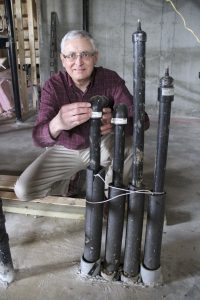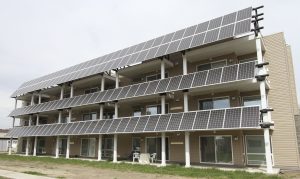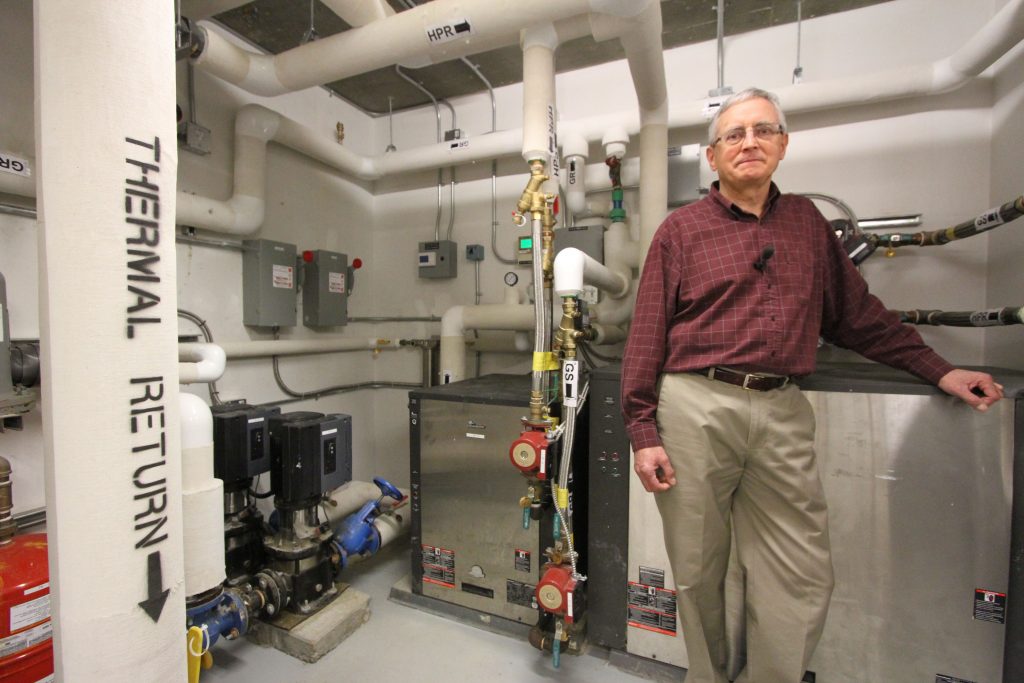By David Dodge and Duncan Kinney

A reminder, the fluid in a ground source heat pump reaches 65 degrees Celsius.
Of all of the sources of green energy, geothermal is probably the least sexy. Solar panels glint in the sunshine and wind turbines spin majestically but there are few evocative descriptors for the humble ground source heat pump.
Once it’s installed there is little visible evidence of its presence in the home except for a few pipes coming out of the basement floor into a furnace-like appliance.
Yet what it lacks in sex appeal it more than makes up for in effectiveness. With over 100,000 ground source heat pumps installed in Canada it’s a proven way to heat and cool homes and buildings.
Geothermal energy is the classic example of an energy supply that is out of sight, out of mind. When student Preetpau Atwal started taking the Alternative Energy Program at NAIT she found that studying geothermal was the most interesting part of her studies.
“It just blew my mind how effective it is – you take energy just sitting there in the ground and you can use it for cooling and heating – it amazes my mind,” says Atwal.
Energy is more than just electricity. Heating a typical single family home in Canada takes up 60 per cent of that family’s total energy consumption. We prefer an ambient temperature of around 20 degrees Celsius. The inside of a natural gas-fired furnace reaches 1,200 degrees Celsius, a ground source heat pump reaches 65 degrees. Which one sounds like the safer, more human scale heating solution?
How six degrees becomes 65 degrees

Leigh Bond of Threshold Energy shows off where the pipes for the geothermal heating system come into the house. These pipes will eventually be hooked up to a ground source heat pump.
If you’ve ever dug an outhouse or a foundation you’re probably familiar with the concept of the frost line. Below the frost line the ground doesn’t freeze. If it doesn’t freeze, then by definition, there is heat there.
In fact 46 per cent of the energy that comes from the giant power plant in the sky is stored as heat in the top 150 metres of the Earth as geothermal energy. So from two meters down to 150 meters you have stored, latent energy just waiting to be tapped by an enterprising home or building owner.
So if the heat is there how do we access it?
The answer is a ground source heat pump. A heat pump isn’t exactly the most exotic piece of technology. Everybody already has a heat pump in their home – your fridge.
A refrigerator uses a heat pump to pump the heat out so it can keep your veggies cool. A heat pump simply pushes heat from one area to another.
A ground source heat pump functions like a fridge in reverse. It pumps the heat from the ground into your house.
Of course it’s a little more complex than that. Holes are drilled and pipes are inserted into the ground below the frost line. Water is circulated in these pipes and brought back to the ground source heat pump at six degrees Celsius. The ground source heat pump then strips three degrees off that flow of water and compresses it which brings the fluid up to 65 degrees Celsius. That hot fluid is put into a radiator where air is blown over it and you have a pleasant, warm building.
Geothermal in the real world

This 2,700 square foot half-done house in the community of Trumpeter in North Edmonton has 14 holes 32 metres deep that will provide all of the heat for the house.
Leigh Bond is the president of Threshold Energies. He designs and builds green energy systems in the Edmonton area. He showed us around a half-built house in the neighborhood of Trumpeter in northwest Edmonton which features a geothermal heating system he designed and installed.
The backyard of this 2,700 square feet house has 14 holes 32 metres deep. Another builder in Medicine Hat that we featured in our pilot episode drilled 10 holes 52 metres deep within the footprint of the patio behind his house.
But as Leigh Bond explains it’s not the depth of the holes that are important since the temperature is the same from two metres to 150 metres down. What’s important is the length of the pipe running through the ground and that it meet the heating load of the house.
Another geothermal system that Leigh Bond recently worked on is housed in the Brentwood Apartments in west Edmonton. It’s an affordable housing complex with 29 units.
The government of Alberta kicked $2.2 million into the project, which is run by the Meadowcroft Housing Society. It’s in a great spot near schools, a bus terminal and across the street from Coronation Park. This net-zero ready apartment building also features technology you don’t find in your everyday affordable housing project. A gleaming bank of solar photovoltaic modules faces sunward on the front of the building but it’s the heating system that’s the most interesting.

The Brentwood Apartments, a 29 unit affordable housing complex has a hybrid geothermal and solar thermal system. This building has no natural gas hookup. The geothermal system provides all of the space heating while the solar thermal system provides 70 per cent of the hot water. The solar thermal system has 20 hot water collectors on the roof and four 200-gallon tanks in the mechanical room.
The hybrid geothermal and solar thermal system means this building has no natural gas hookup. The geothermal system provides all of the space heating while the solar thermal system provides 70 per cent of the hot water.
The solar thermal system has 20 hot water collectors on the roof and four 200-gallon tanks in the mechanical room. Any surplus heat from the solar hot water system on hot sunny days ends up getting pumped into the ground loops of the geothermal system.
Yeah, yeah, yeah – what does it cost?
The easiest way to ballpark what a geothermal heating system would cost in your home is to figure out how many cubic feet you have to heat. This includes the basement. A standard 2,000 square foot bungalow with an equivalent basement and eight-foot ceilings comes to 32,000 cubic feet. You multiply that by $1.81 and your rough cost comes to $58,000.
Seems high right. Let’s dive into the numbers a little more.
An equivalent natural gas furnace, forced air heating system and gas-fired hot water tank is going to run you $24,000 to $26,000. Add another $6,000 for an in- floor system and add a bit more for touches like a tankless hot water system.
So the real additional cost for a geothermal system is an extra $22,000 to $34,000. However, by avoiding the need for a natural gas hookup you not only avoid a gas bill you avoid paying administrative fees, municipal franchise fees and fixed delivery charges. Natural gas is very cheap right now, but it’s unlikely to remain low over the average lifespan of a ground source heat pump, which is 22 years. And by not having a gas line you dodge more than $8,000 in fees over 22 years and that’s without buying a single joule of gas.
However, there is a corresponding rise in electricity charges. Bond says that, on average, your electric bills go up by 30 per cent with geothermal heating. Payback, according to Bond, will be 14 to 22 years depending on how you do the calculations.
They may not be all that visible, but there are already more than 100,000 geothermal heating systems installed in homes and businesses across Canada.
You may not have shiny solar panels to show off to the neighbours, but they will surely give their heads a shake when you say that you are heating your home with heat from the earth that is just six degrees Celsius.

Leigh Bond in the mechanical room of the Brentwood Apartments next to the two large heat pumps which provide all of the space heating and backup hot water heating for the 29 unit affordable housing complex.

